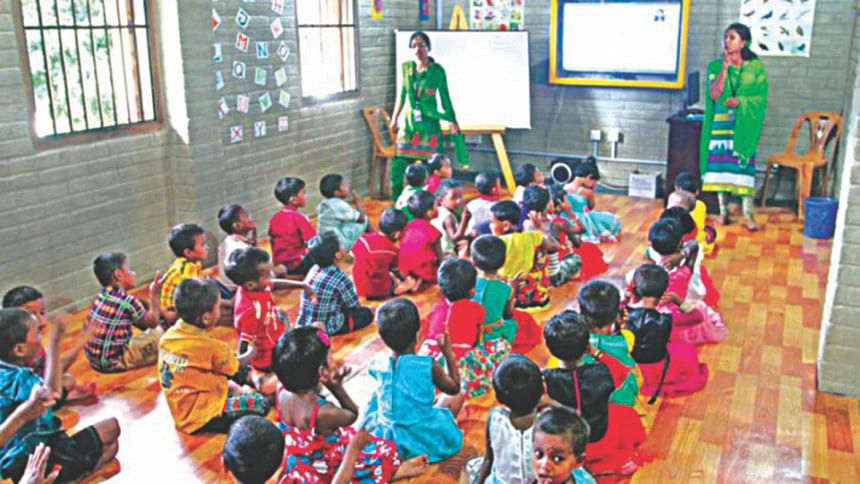EACH CHILD TO A LOCAL SCHOOL

Each six-year-old child would be admitted to a neighbourhood primary school without being subjected to a qualifying test – this is how it should work because the country has a mandatory education law in place since 1990. But it hardly works this way.
Prime Minister Sheikh Hasina, at the Bangladesh Shishu Academy's observance of World Children's Day on October 11, said that every child must find a place in a neighbourhood school. "If the child seeking to enter a pre-primary or primary class has to sit for an exam to prove he/she can read and write, then what is the job of the school?" she asked. "It is the child's right to be admitted to a neighbourhood school," she said.
The Prime Minster instructed the officials present from the Ministry of Primary and Mass Education, Ministry of Education and the Ministry of Women and Children Affairs to take necessary steps to ensure that every child can enroll in a school in the locality. And they should not have to cross the barrier of an admission test. She also directed that the Prime Minister's Office should undertake the necessary coordination.
The Prime Minster has a knack for getting to the core of a complex issue and look for a simple solution when she feels strongly about the problem. Why should the child be denied access to a local school by setting up an admission barrier, when it is the child's right to be in a local school? The responsible agencies must find a solution and make it happen, according to the unassailable logic of the Prime Minister.
But will it happen? How long will it be before we see every child is indeed welcomed in a local school close to her/his home? That the head of the government feels strongly about it is a great boost to the cause. That her office might follow up actions that should be taken will no doubt help.
To make sure that the intended results are achieved, various steps, which should have been taken long ago, must be taken. We are talking about almost 8 million children around 5-6 years old who seek admission in more than 100,000 pre-primary and grade 1 classes of primary schools in over a hundred thousand rural areas, towns and city communities.
The conditions in villages, towns and large cities differ, as do situations within each of these settlements. There are public, private, voluntary, and NGO institutions as well as madrasas. There are great differences in the quality and reputation of these institutions. Every parent wants to send their child to the school with the best reputation. Some schools are in great demand, while others don't enjoy the same advantage. Often those in demand are private schools, which require high tuition and other fees.
On the other hand, there is the government's legal authority, administrative mechanisms and power to persuade. Citizens and communities desire to ensure good education for their children. The educational institutions, at least the large majority of them, have the goal of serving their students well. How can these positive forces be brought together to achieve what the Prime Minister wants?
There has to be locality-based planning for each rural union and city ward to examine where we stand and what needs to be done. Coordinated action can be planned, involving all service providers – government, corporates and NGOs – to assess and decide what can be done now and in the near future in each locality.
Besides the two Ministries of Education, the local government bodies and the Ministry of Women and Children Affairs should also be part of the area-based planning. The latter has a special role in promoting schooling of children through preschool and early childhood development.
India has adopted a right to education law which obligates private schools to offer free education to 25 percent of the entry class positions to neighbourhood children from poor families. Why should we not adopt such a law?

 For all latest news, follow The Daily Star's Google News channel.
For all latest news, follow The Daily Star's Google News channel. 



Comments